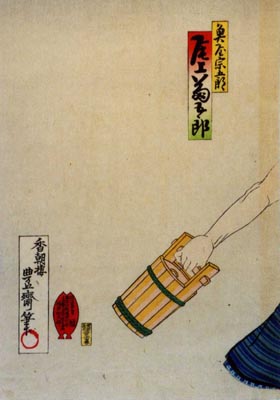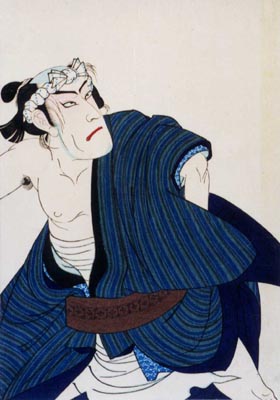| SAKANAYA SďGORď |
| Play title | Shin Sarayashiki Tsuki no Amagasa Moonlit Umbrella at the Dish Palace, New Version* |
| Authors | Kawatake Mokuami |
| History |
The play "Shin Sarayashiki Tsuki no Amagasa" was performed for the first time at the Ichimuraza in May 1883 [casting]. |
| Structure |
"Sakanaya S˘gor˘" (literally "S˘gor˘ the fish seller") is the second part of "Shin Sarayashiki Tsuki no Amagasa" and the most popular one. It is often staged independently. |
| Key words |
Shiba Sewamono Sakeoke Taishuka |
| Summary |
The play starts in Shiba (in downtown Edo) on a day when people in the area are celebrating the festival of their guardian deity. The streets are crowded with people and bands. But in S˘gor˘'s house, Ohama and Sankichi are deeply depressed over the death of S˘gor˘'s younger sister, Otsuta. Otsuta was well-known among the neighbors for her gentle manner and her devotion to her parents. As Lord Isobe's concubine, she was well taken care of until, as rumor had it, he himself killed her for having committed adultery. People, however, cannot believe that she had become so wanton as to be double-timing her lord and master. When S˘gor˘ gets home, his father is shouting in lament, "We did not ask to send Otsuta to Lord Isobe's residence. We were urged to do so and could not refuse his request. And now she has been executed!" S˘gor˘, too, was mortified. But he couldn't help thinking of how Otsuta's allowance had saved his family from poverty and felt he must calm his father down. In fact, he himself had been freed from debt by the money they received. Ohama offers him sake wine, his favorite, in consideration of his feelings. But he refuses. In the past his tendency to drink to excess had robbed him of his powers of reason and brought on many failures. So he has solemnly sworn off alcohol forever. Just then the apprentice of a local liquor merchant brings in a barrel of sake. He explains that a beautiful maid-servant ordered it to be delivered there. The maid in question proves to be Onagi, who had taken care of Otsuta at Isobe's residence. S˘gor˘'s family asks her why Isobe killed Otsuta. According to Onagi, when Otsuta went out of find her pet cat, Tenz˘, who had become hopelessly infatuated with her, accosted her and made advances. Hearing her scream, Urato's younger brother rushed to her rescue. But Tenz˘ ran off just before he arrived and then fingered the pair as illicit lovers. He made the accusation not only because he thought he must revenge himself upon Otsuta for repulsing his advances, but also because she had overheard him and his father discussing plans to overthrow the Isobes. And without checking the facts carefully, Isobe, a quick-tempered and simple man who tended to act rashly under the influence of sake, brutally killed Otsuta and dumped her body into an old well in the garden. In short, Otsuta had been unjustly accused and punished. She had been completely innocent. In light of these circumstances, no one present is able to restrain their anger. S˘gor˘, in particular, feels great pity for his younger sister. He can keep his vow to stop drinking no longer. At last he begins to drink the sake which Onagi thoughtfully presented as a token of her heart-felt sympathy for S˘gor˘'s family. As he drinks more and more, his movements become more and more animated. Finally he gets so worked up as not to be able to restrain himself. S˘gor˘, who detests any injustice, runs off at full speed towards Isobe's residence shouting, "I going to Isobe to demand an explanation of why he killed my dear sister. I'll never be satisfied until I hear it from him directly." Next we see a very drunk S˘gor˘ at the front door of Isobe's residence. He threatens to create a disturbance and to expose how Lord Isobe has murdered his sister. Tenz˘ has him subdued and tied up for fear that his own wrong doing will come to light. Anxious about her husband's rash behavior, Ohama, who has followed him, arrives. Knowing that nobody can tell what S˘gor˘ might do when he's drunk, she pleads for mercy with everybody surrounding her husband. Still struggling hard, S˘gor˘ kicks at Tenz˘. He gets angry and is about to cut S˘gor˘ down when Isobe's chief retainer, Urato, intercedes. He orders S˘gor˘ untied. Realizing that Urato is a reasonable man, S˘gor˘ begins to confess his strong feelings. And although Urato understands his position, he declines, for the time being, to publicly support S˘gor˘. All he can do now is to try to calm S˘gor˘ down. In contrast to Ohama, who is trembling for fear of her husband's fate, S˘gor˘ dozes off. Tenz˘ thinks he must assassinate Urato because he has an instinctive fear that the true facts might be revealed. While S˘gor˘ is fast asleep in the garden, worrying by his side is Ohama. Soon S˘gor˘ awakens and returns to his senses. His wife tells him all that has happened while he was drunk. And he begins feeling ashamed of his rude behavior just as Lord Isobe's entrance is announced. S˘gor˘ prepares for the worst. But his violent behavior is overlooked out of consideration for poor Otsuta. Judgment has been reached in consultation with Urato. Isobe apologizes from the bottom of his heart saying, "I was very rash and my judgment had been impaired by drink. I very much regret what I did." He asks S˘gor˘ to accept condolence money for Otsuta, offers an allowance to the father, and proclaims that he is going to punish Tenz˘ and his father. This summary has been written by Watanabe Hisao and edited by Jeff Blair [website] (*) the title "Moonlit Umbrella at the Dish Palace, New Version" comes from the 4th volume of "Kabuki Plays On Stage". |
| Comments |
The role of S˘gor˘ belongs to the Otowaya guild since its creation for Onoe Kikugor˘ V, who transmitted it to his son Onoe Kikugor˘ VI, who taught it to his disciple Onoe Sh˘roku II and his son-in-law Nakamura Kanzabur˘ XVII. 3 great actors inherited it and perform it regularly : Onoe Kikugor˘, Nakamura Kankur˘ and Nakamura Tomijűr˘. This play is also an important one in the Kabuki repertory of the famous Zenshinza troupe: the great actor Nakamura Kan'emon III played S˘gor˘ many times and his son Nakamura Umenosuke is his praiseworthy successor. "This play belongs to the group of sewamono depicting the uneasy relations between the upper and lower classes in the late 18th century. It is not a particularly good play, but it is often performed because it affords the chief actor a splendid opportunity in the scene where he breaks his vow and takes to drink again." (Aubrey and Giovanna Halford in "The Kabuki Handbook") |
 |
 |
|
Onoe Kikugor˘ V playing the role of S˘gor˘ in the "Sakanaya S˘gor˘" part of the drama "Shin Sarayashiki Tsuki no Amagasa", which was performed at the Kabukiza in September 1899 (print made by K˘ch˘r˘ H˘sai) |
|
|
|
| Contact | Main | Top | Updates | Actors | Plays | Playwrights | Programs | Links | FAQ | Glossary | Chronology | Illustrations | Prints | Characters | Derivatives | Theaters | Coming soon | News |